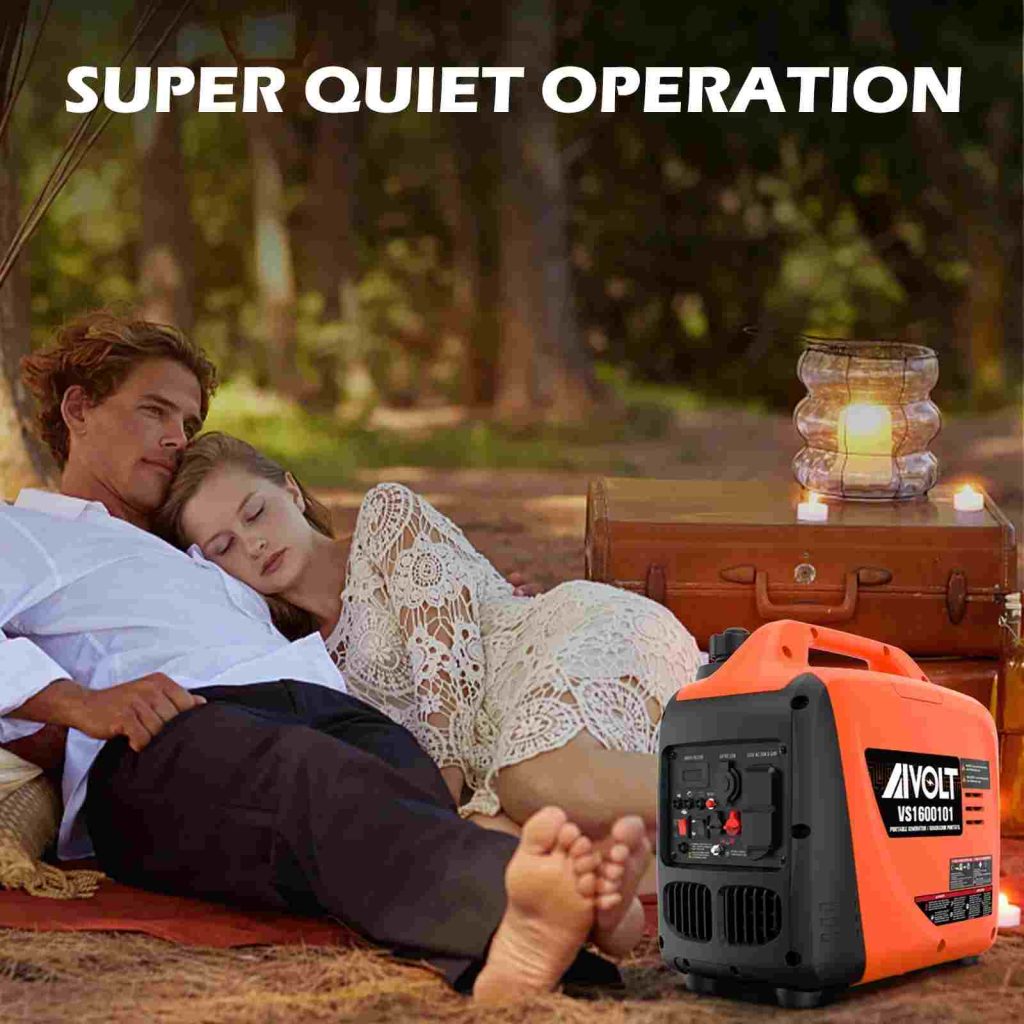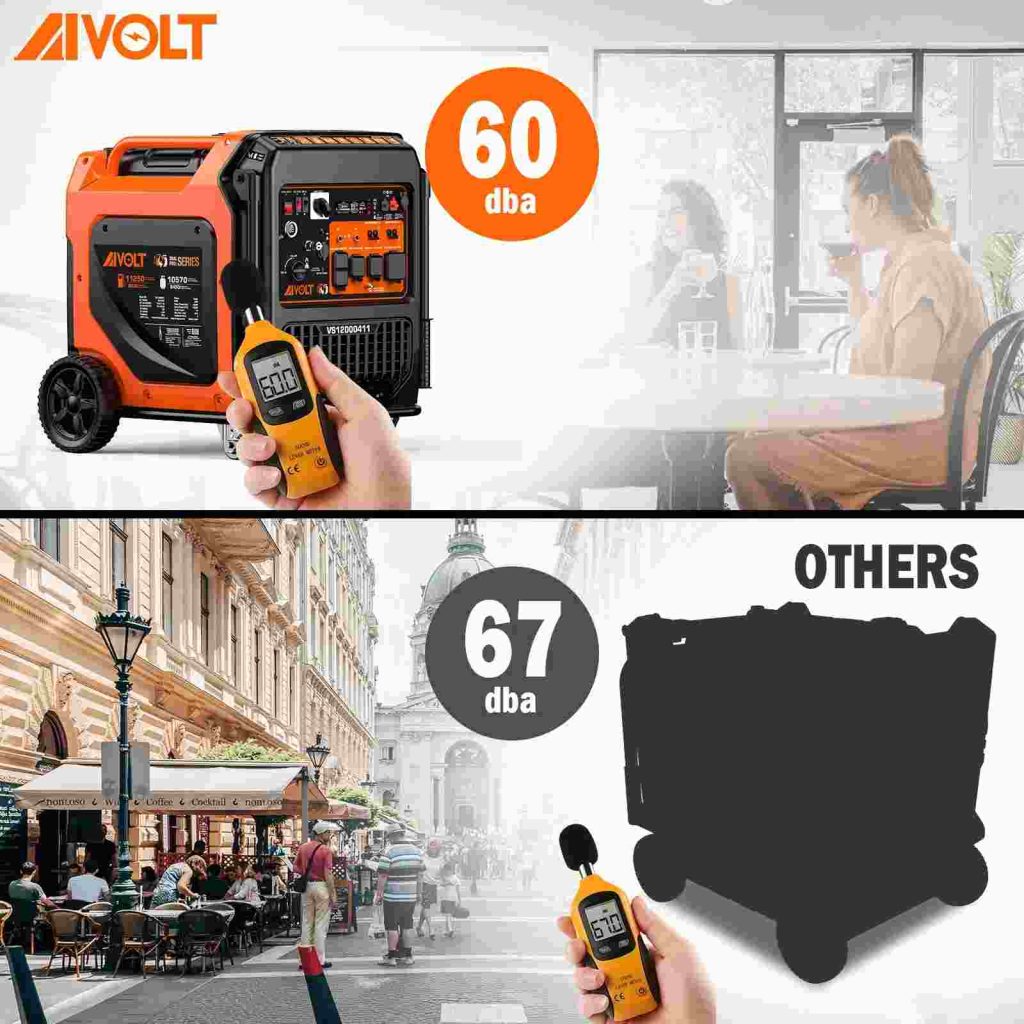Why Are Inverter Generators So Quiet?
At a mountain campsite, you may want to boil hot tea or charge camera batteries without a generator’s roar ruining the tranquility. On a power outage night, you need reliable electricity for fridges and lights but don’t want noise disturbing your family. At outdoor construction sites or tailgate parties, you need power for tools or speakers without noise being an unwelcome guest. These scenarios, where “quietness” and “power supply” are both needed, make inverter generators a top choice.
Unlike loud traditional generators, super quiet inverter generators run at conversational volume, meeting power needs unobtrusively. But why are they so quiet? Is it mere “noise packaging” or a full innovation in tech and design? Let’s break down their “quiet code”.

Noise Sources of Traditional Generators
To understand inverter generators’ quietness, we first clarify why traditional models (mostly open-frame synchronous generators) are noisy. Their noise stems from overlapping sources—mechanical operation, electromagnetic vibration, and exhaust disturbance—rooted in unavoidable flaws in their working principle.
The traditional generators are driven by internal combustion engines that drive the rotors to high speeds. They convert mechanical energy into electricity through electromagnetic induction.
Engine friction and vibration are the first source of noise
Piston rotation, crankshaft impact and valve collisions produce high-frequency sound.
Meanwhile, the engine’s overall vibration spreads to the ground/brackets, causing structural resonance and penetrating low-frequency noise that travels far outdoors .
Second is electromagnetic interference and current fluctuations
Lacking an “intermediate adjustment link,” rotor speed directly dictates output frequency. To maintain 50/60Hz AC power, the engine must run constantly at over 3,000 rpm—even under light loads like phone charging—sustaining high mechanical noise . Additionally, electromagnetic force changes between stators and rotors cause core vibration, producing a “buzzing” sound that worsens with unstable loads.

Third is the exhaust and cooling systems
Simple straight exhaust outlets let high-temperature gas rush out, colliding with air to make sharp noise. Cooling fans run at high speeds for engine cooling, creating airflow noise as air passes blades and grilles—both are prominent outdoors .
A common 5kW open-frame model produces 75-90 decibels at 10 feet: 75 dB like a busy street, 90 dB near a motorcycle’s startup. This irritates users and risks hearing damage with long-term exposure. These pain points are exactly where inverter generators achieved technical breakthroughs.
The Unique Noise-Reduction Principle of Inverter Technology
If traditional generators’ noise is a “principles-based defect”, inverter generators’ quietness comes from an “innovative technical route”. Its core is adding an intermediate link of “DC conversion and inverter regulation”, which cuts noise at the power source—this is the key meaning of “inversion”.
Noise-Reduction Advantages of DC Conversion
Inverter generators generate power in three steps: the internal combustion engine drives the generator to produce DC; a rectifier turns unstable DC into stable DC; an inverter converts DC to standard AC. This “AC-DC-AC” process breaks the “speed-determines-frequency” constraint, laying the foundation for noise reduction.
Unlike traditional generators (which need constant high engine speed to maintain frequency), inverter generators let the engine adjust speed by load. Under light loads (e.g., phone charging), the engine drops to below 1500 rpm, reducing friction, vibration, and noise. Under heavy loads (e.g., power drills), it speeds up to ensure power. This “on-demand speed” avoids traditional generators’ “idle roaring”.
Take the AIVOLT 1600W model: its 60cc 4-stroke OHV engine runs at ~1800 rpm under 25% load (300W), cutting mechanical noise sharply. Traditional generators, by contrast, stay at 3600 rpm even under the same load. DC’s stability also reduces current fluctuation impact on the electromagnetic system, lowering electromagnetic noise by 15%-20%.
Precise Frequency Control
Beyond “on-demand speed”, inverter technology enables “precise frequency control”—boosting power quality and cutting noise further. Traditional generators’ frequency depends on engine speed stability; slight speed fluctuations (e.g., load changes) distort frequency and amplify electromagnetic vibration. Inverter generators use advanced electronics and algorithms for “millisecond-level frequency adjustment”.
The AIVOLT 1600W has a high-precision PLC and voltage sensors that monitor output frequency/voltage in real time. When loads fluctuate, sensors send signals to the PLC, which adjusts the inverter’s switching frequency to stabilize AC at 60Hz (error <0.1Hz) and voltage at 120V (error <2V). This avoids frequency-related electromagnetic vibration and “buzzing” noise.
Inverter generators also output “pure sine waves” with THD <3% (AIVOLT’s parameter), vs. 5%-10% for traditional models. Lower THD means smoother current waveforms, less appliance impact, and calmer electromagnetic vibration—explaining why they’re quiet and safe for sensitive devices like phones.
Inverter Generator Vs Traditional Generator
Technical principles and design descriptions alone are not enough—data is the most intuitive way to verify the quiet advantage of inverter generators. Taking the AIVOLT 1600W ultra-quiet inverter generator as a sample, we compare it with a same-power traditional open-frame generator in terms of noise, fuel consumption, and applicable scenarios to see its true “quiet strength”.
(1) Noise Decibel Comparison
The noise measurement is based on a standard. In an open, unobstructed environment, the noise levels are measured 10 feet (3 meters) away from the generator and at a distance of 23 feet (7 meters), both under conditions of no load (no consumption of power) and full load (rated power). Results are displayed in the following table:
| Generator Type | Measurement Distance | No-Load Noise (dB) | Full-Load Noise (dB) | Noise Perception |
| Traditional Generator | 10 feet | 72-78 | 78-85 | Similar to busy street noise, obviously harsh |
| AIVOLT Inverter Generator | 10 feet | 52-55 | 55-58 | Close to normal conversation volume, no obvious discomfort |
| Traditional Generator | 23 feet | 68-72 | 72-78 | Still clearly audible, affecting rest |
| AIVOLT Inverter Generator | 23 feet | 48-50 | 50-52 | Weak noise, blending into background |
Data shows that the AIVOLT inverter generator is over 20 dB quieter than the traditional one, whether under no-load or full-load. According to acoustic principles, every 10 dB reduction halves the perceived sound intensity—meaning the AIVOLT’s noise intensity is only about 1/4 that of traditional generators, causing almost no environmental disturbance in scenarios like camping or home emergencies.
The “roar” of a conventional generator can be heard from 10 meters away. This may cause neighbors to complain. The AIVOLT inverter generator, at 7 meters, only produces a noise of 50 dB. This is similar to wind rustling through leaves.

(2) Applicable Scenario Comparison
Beyond noise and fuel consumption, the two types of generators also differ significantly in applicable scenarios—directly related to their quietness:
| Applicable Scenario | Traditional Generator | AIVOLT Inverter Generator | Core Reason |
| Camping, Tailgate Parties | Not recommended | Highly recommended | Traditional generators are too noisy (ruining experience); inverter ones are quiet (blending in) |
| Home Emergency Power | Limited use | Recommended | Traditional generators disturb family rest; inverter ones are quiet (suitable for indoor vicinity) |
| Small-Scale Outdoor Construction | Applicable but limited | More applicable | Traditional generators may disturb nearby residents; inverter ones are quieter (better compliance) |
| Sensitive Electronic Device Power | Not applicable | Recommended | Traditional generators have large current fluctuations (damaging devices); inverter ones have THD < 3% (safe power supply) |

Inverter generators have a quieter sound than other generators. This not only improves the user’s experience, but also expands the range of possible scenarios. Inverter generators are the ideal solution when you need a quiet source of power, for example, if your power requirements are long-term or if you want to power sensitive electronics such as laptops and smartphones.
Ready to Get A Quiet Inverter Generator?
If you’re tired of the loud roar of traditional generators and want to enjoy the tranquility of the mountains while boiling tea during camping, or have quiet power supply without disturbing rest when there’s a home power outage, the AIVOLT ultra-quiet inverter generator is the perfect choice for you. Don’t hesitate! Come to AIVOLT to choose your favorite inverter generator!


